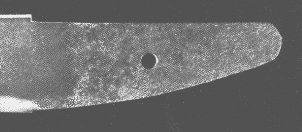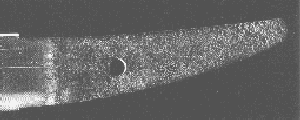

The Nakago is the tang of a Japanese blade. It is called Ubu if it has not been shortened or altered , i.e. if the Nakago Jiri (tang tip), the Ha Machi and the Mune Machi (points at which the tang gives way to the blade) are in their original positions. If the blade has been remounted at some point in its history and has had additional Mekugi Ana (peg holes) drilled, it is still regarded as Ubu. The patina and depth of rust on the nakago is an important factor in kantei (appraisal), and so the nakago should NEVER be cleaned or polished.
Many nakago have been altered or shortened due to remounting or conversion of blades from one type to another (e.g. as when a tachi is cut down to make a wakizashi). The following terms are used to describe altered nakago:
Suriage is used to describe a blade which has been shortened. Blades are always reduced by shortening the nakago, never by shortening the kissaki. When the nakago has been cut down, the mune machi and the ha machi are usually moved up the blade to maintain something approaching the original length of the nakago.
ď Suriage describes a blade which has been greatly shortened. Often in these cases so much of the original nakago is removed that the mei is lost. The new nakago is formed from the original blade by cutting new ha and mune machi.
Orikaeshi Mei describes cases of ď Suriage where that part of the nakago bearing the mei is retained and bent through 180 degrees to form part of the new nakago.
Gaku Mei is where the old mei is cut as a rectangle from the old nakago and then is let into the new one.

This general form is the nakago type which occurs most frequently.

Kiji Momo (Mata) means 'pheasant thigh'. This form of nakago is often seen on tachi (long swords) from the Heian and Kamakura periods.

This nakago form is characterised by its flattened lower portion. It is often see on tant˘

Gohei refers to its resemblance to the pieces of paper which are attached to the sacred straw rope festoon used within Shinto shrines. This tang form was first used by Ise no Kami Kuniteru in the Edo period.

Funa means 'boat'. The nakago is so called because it is redolent of a boat shape. This form is associated with the S˘shű school founded by Masamune.

The Furisode form is so named because of its resemblance to the long sleeve of a young lady's kimono. It typically has strong sori and is usually found on shorter blades and tant˘ of the Kamkura period.

Tanago Bara refers to similarity of this form to the belly of a particular fish. It is particularly seen amongst the Muramasa, Heianj˘ Nagayoshi and Shitahara schools during the Muromachi period.